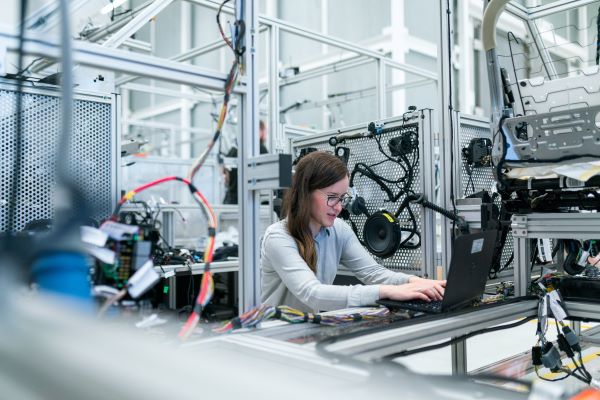
Why Renewable Energy Needs the Next Generation of OT/ICS Cybersecurity Professionals
13 Sept, 20235
Contents
- Understanding the Skill Gap in Renewable Energy Sector
- The Current State of Cybersecurity in Renewable Energy
- Identifying the Skill Gap in OT/ICS Cybersecurity
- The Importance of Cybersecurity in Renewable Energy
- Potential Risks and Threats in the Renewable Energy Sector
- The Role of Cybersecurity in Safeguarding Renewable Energy
- The Next Generation of OT/ICS Cybersecurity Talent
- Required Skills and Competencies for Future Cybersecurity Professionals
- The Impact of Advanced Cybersecurity on Renewable Energy
- Strategies to Bridge the Skill Gap
- Education and Training Initiatives for Cybersecurity Talent
- The Role of Government and Industry in Bridging the Skill Gap
- The Future of Renewable Energy and Cybersecurity
- Predicted Trends in Renewable Energy Cybersecurity
- Preparing for the Future: Next Steps for the Industry
Renewable energy is rapidly transforming the global energy landscape, offering a sustainable and cleaner alternative to traditional fossil fuels. As the demand for renewable energy sources continues to grow, so does the need for robust cybersecurity measures to protect these critical infrastructures from malicious actors. However, there is a significant skill gap in the renewable energy sector when it comes to OT/ICS (Operational Technology/Industrial Control Systems) cybersecurity. Bridging this gap has become a pressing need to ensure the reliability and security of our renewable energy infrastructure.
Understanding the Skill Gap in Renewable Energy Sector
The current state of cybersecurity in the renewable energy sector warrants serious attention. Over the years, the sector has witnessed an increase in cyber threats and attacks. Hackers are constantly seeking vulnerabilities in renewable energy systems, aiming to disrupt operations, steal sensitive data, and potentially cause physical damage. These threats pose immense risks to the reliability and stability of renewable energy sources. It is crucial to address this skill gap to mitigate such risks and ensure the long-term viability of renewable energy.
Identifying the skill gap in OT/ICS cybersecurity is the first step towards bridging it effectively. Many experts believe that the renewable energy sector, unlike other industries, lacks sufficient cybersecurity expertise. The traditional IT security professionals often lack the specialized knowledge required to protect operational technology and industrial control systems. Moreover, the nuances of renewable energy systems necessitate a unique skill set that combines cybersecurity expertise with a deep understanding of renewable energy infrastructures.
One of the key challenges in addressing the skill gap is the rapidly evolving nature of cyber threats. As hackers become more sophisticated and innovative in their tactics, it becomes essential for cybersecurity professionals to stay updated with the latest trends and technologies. In the renewable energy sector, this becomes even more critical due to the interconnectedness of various systems and the increasing reliance on digital technologies.
Another aspect that contributes to the skill gap is the lack of standardized training and certification programs specifically tailored for cybersecurity in the renewable energy sector. While there are general cybersecurity certifications available, they may not cover the intricacies and specific challenges faced by the renewable energy industry. Developing industry-specific certifications and training programs can help bridge this gap and ensure that cybersecurity professionals have the necessary knowledge and skills to protect renewable energy systems effectively.
Furthermore, collaboration between the renewable energy sector and academia can play a crucial role in addressing the skill gap. By establishing partnerships and research collaborations, industry professionals can work closely with academic institutions to develop curriculum and training programs that align with the industry's needs. This collaboration can also facilitate knowledge sharing and exchange of best practices, ultimately enhancing the overall cybersecurity posture of the renewable energy sector.
Investing in workforce development and talent acquisition is another important strategy to bridge the skill gap. By attracting and retaining skilled cybersecurity professionals, the renewable energy sector can strengthen its defense against cyber threats. This can be achieved through various initiatives such as internships, apprenticeships, and scholarship programs that specifically target individuals interested in pursuing a career in renewable energy cybersecurity.
Lastly, continuous monitoring and assessment of the skill gap is essential to ensure that the efforts to bridge it are effective. Regular evaluations can help identify any gaps in the existing training programs or areas that require further improvement. By staying vigilant and adaptive, the renewable energy sector can proactively address the skill gap and build a robust cybersecurity workforce.
The Importance of Cybersecurity in Renewable Energy
The potential risks and threats facing the renewable energy sector are extensive. Malicious actors can exploit vulnerabilities in renewable energy systems to gain unauthorized access, manipulate data, and disrupt energy supply. An attack on renewable energy infrastructure could have catastrophic consequences, resulting in prolonged power outages, economic losses, and even endangering lives. Cybersecurity measures play a vital role in safeguarding these systems and ensuring their continuous and secure operation.
By integrating effective cybersecurity measures, renewable energy providers can protect critical assets, maintain the integrity of data, and enhance their overall resilience. Such measures inspire trust and confidence in the reliability and security of renewable energy systems. As renewable energy continues to expand its reach and become an integral part of our energy mix, the importance of cybersecurity in this sector cannot be overstated.
One of the key aspects of cybersecurity in renewable energy is the protection of sensitive data. Renewable energy systems generate vast amounts of data, including information about energy production, consumption patterns, and grid performance. This data is crucial for optimizing renewable energy systems and making informed decisions. However, it also makes these systems attractive targets for cybercriminals.
With the increasing adoption of Internet of Things (IoT) devices in renewable energy systems, the attack surface for potential cyber threats has expanded. IoT devices, such as smart meters and sensors, enable real-time monitoring and control of renewable energy infrastructure. However, they also introduce new vulnerabilities that need to be addressed through robust cybersecurity measures.
Another important aspect of cybersecurity in renewable energy is the protection of intellectual property. The renewable energy sector is driven by innovation, with companies constantly developing new technologies and solutions to improve efficiency and sustainability. Intellectual property theft can have severe consequences, not only for the affected companies but also for the overall progress of renewable energy as a whole.
Cybersecurity in renewable energy also involves ensuring the physical security of critical infrastructure. Renewable energy systems, such as wind farms and solar power plants, are often located in remote areas, making them vulnerable to physical attacks. By implementing comprehensive security measures, including surveillance systems and access controls, the risk of physical tampering can be mitigated.
Furthermore, the interconnected nature of renewable energy systems introduces additional cybersecurity challenges. Renewable energy infrastructure is often integrated with existing power grids, creating complex networks that require robust protection against cyber threats. The potential for cascading effects and widespread disruptions necessitates the implementation of advanced cybersecurity measures to prevent and mitigate such incidents.
As the renewable energy sector continues to evolve and expand, so do the cybersecurity risks. It is essential for renewable energy providers, policymakers, and stakeholders to collaborate in developing and implementing effective cybersecurity strategies. This includes regular risk assessments, employee training, and staying updated on the latest cybersecurity threats and technologies.
In conclusion, cybersecurity is of paramount importance in the renewable energy sector. It protects critical assets, ensures the integrity of data, and enhances the overall resilience of renewable energy systems. By addressing the various cybersecurity challenges, the renewable energy sector can continue to grow and contribute to a sustainable and secure energy future.
The Next Generation of OT/ICS Cybersecurity Talent
Addressing the skill gap in OT/ICS cybersecurity requires nurturing the next generation of cybersecurity professionals with the required skills and competencies. This new breed of professionals must possess a solid foundation in cybersecurity principles and practices, with a specific focus on OT/ICS environments. They need to understand the unique challenges and complexities associated with securing renewable energy infrastructures.
As the world continues to shift towards renewable energy sources, the need for robust cybersecurity measures in the renewable energy sector becomes increasingly critical. The integration of renewable energy systems into the power grid introduces new vulnerabilities that can be exploited by malicious actors. Therefore, the next generation of OT/ICS cybersecurity professionals must not only be well-versed in traditional cybersecurity practices but also possess a deep understanding of renewable energy systems and their vulnerabilities.
Advanced technical knowledge is a fundamental requirement for future cybersecurity professionals. They must have a comprehensive understanding of network protocols, encryption algorithms, and intrusion detection systems. Moreover, they need to stay updated with the latest advancements in technology, such as artificial intelligence and machine learning, as these emerging technologies play a significant role in enhancing cybersecurity defenses.
Critical thinking abilities are essential for OT/ICS cybersecurity professionals. They must be able to analyze complex systems and identify potential vulnerabilities and threats. This requires a deep understanding of the underlying technologies and the ability to think outside the box to anticipate and mitigate potential risks. Additionally, adaptability is crucial in the ever-evolving field of cybersecurity, as new threats and attack vectors emerge regularly.
While technical skills are vital, cybersecurity professionals in the renewable energy sector must also possess the ability to collaborate effectively with diverse stakeholders. Securing renewable energy infrastructures requires close cooperation between government agencies, energy companies, and cybersecurity experts. Therefore, future professionals must have strong communication and interpersonal skills to build relationships and foster collaboration.
Developing innovative solutions is another key attribute for the next generation of OT/ICS cybersecurity professionals. As the threat landscape continues to evolve, traditional security measures may not be sufficient to protect renewable energy infrastructures. Therefore, professionals must be able to think creatively and develop novel approaches to address emerging cybersecurity challenges.
Strategies to Bridge the Skill Gap
In order to bridge the skill gap effectively, a multi-faceted approach is required. Education and training initiatives play a pivotal role in equipping the next generation of cybersecurity talent with the necessary skills. Academic institutions should develop specialized programs that combine cybersecurity with renewable energy systems to produce well-rounded professionals.
These specialized programs can delve into the intricacies of securing renewable energy infrastructures, addressing the unique challenges and vulnerabilities that arise in this sector. Students will gain a deep understanding of the technologies involved in renewable energy systems, such as solar panels, wind turbines, and energy storage devices. They will also learn how to identify and mitigate potential cyber threats that could disrupt the operation of these systems, ensuring the reliable and secure generation of clean energy.
In addition to formal education, industry-led training programs and certifications can provide practical knowledge and hands-on experience in securing renewable energy infrastructures. These programs can simulate real-world scenarios, allowing participants to apply their skills in a controlled environment. By working on simulated attacks and defenses, aspiring cybersecurity professionals can develop the necessary expertise to protect renewable energy systems from malicious actors.
Collaboration between academia and industry is paramount to tailor programs that align with the current and future needs of the renewable energy sector. By actively involving industry experts in curriculum development, educational institutions can ensure that the skills taught are relevant and up to date. This collaboration can also facilitate the exchange of knowledge and best practices, allowing academia to stay informed about the latest cybersecurity threats and trends in the renewable energy industry.
Government and industry must also play a proactive role in bridging the skill gap. Governments can offer funding and support for cybersecurity initiatives, encouraging research and development in the field. By investing in cutting-edge technologies and innovative solutions, governments can foster an environment that promotes cybersecurity excellence in the renewable energy sector.
Industry collaboration can provide internships, apprenticeships, and mentorship programs to ensure practical exposure for aspiring cybersecurity professionals. These opportunities allow students to gain firsthand experience in securing renewable energy infrastructures under the guidance of industry experts. Through mentorship programs, experienced professionals can share their knowledge and insights, helping to shape the next generation of cybersecurity talent.
Furthermore, industry can actively participate in job fairs and career events, showcasing the diverse range of opportunities available in the renewable energy cybersecurity field. By highlighting the exciting and rewarding nature of these roles, industry can attract more individuals to pursue a career in this niche sector.
The Future of Renewable Energy and Cybersecurity
The renewable energy sector is poised for significant growth in the coming years. As technologies evolve and the sector expands, so does the complexity of the cybersecurity challenges. To prepare for the future, the industry must anticipate and adapt to these challenges.
Predicted trends indicate that renewable energy cybersecurity will focus on proactive threat intelligence, real-time monitoring, and incident response capabilities. Artificial Intelligence (AI) and machine learning technologies will also play a crucial role in identifying potential vulnerabilities and mitigating cyber risks. Additionally, collaboration with government agencies and international organizations can foster information sharing and best practices to create a global network of cybersecurity professionals dedicated to protecting renewable energy infrastructures.
Preparing for the Future: Next Steps for the Industry
The renewable energy sector must act swiftly and decisively to bridge the skill gap in OT/ICS cybersecurity. Education, training, and collaboration between academia, industry, and government are key to nurturing the next generation of cybersecurity talent. By investing in the development of specialized programs, providing practical training opportunities, and promoting collaborative initiatives, the sector can ensure that it has skilled professionals capable of protecting renewable energy infrastructures against emerging cyber threats.
As we aspire to create a greener and more sustainable future, it is vital that we bridge the skill gap and bolster the security and reliability of renewable energy sources. The next generation of OT/ICS cybersecurity talent will be at the forefront of this endeavor, ensuring the safe and uninterrupted supply of renewable energy. If you're seeking to hire cybersecurity professionals who can contribute to this mission, don't hesitate to contact us. Let us help you find the right talent to secure the future of renewable energy.


